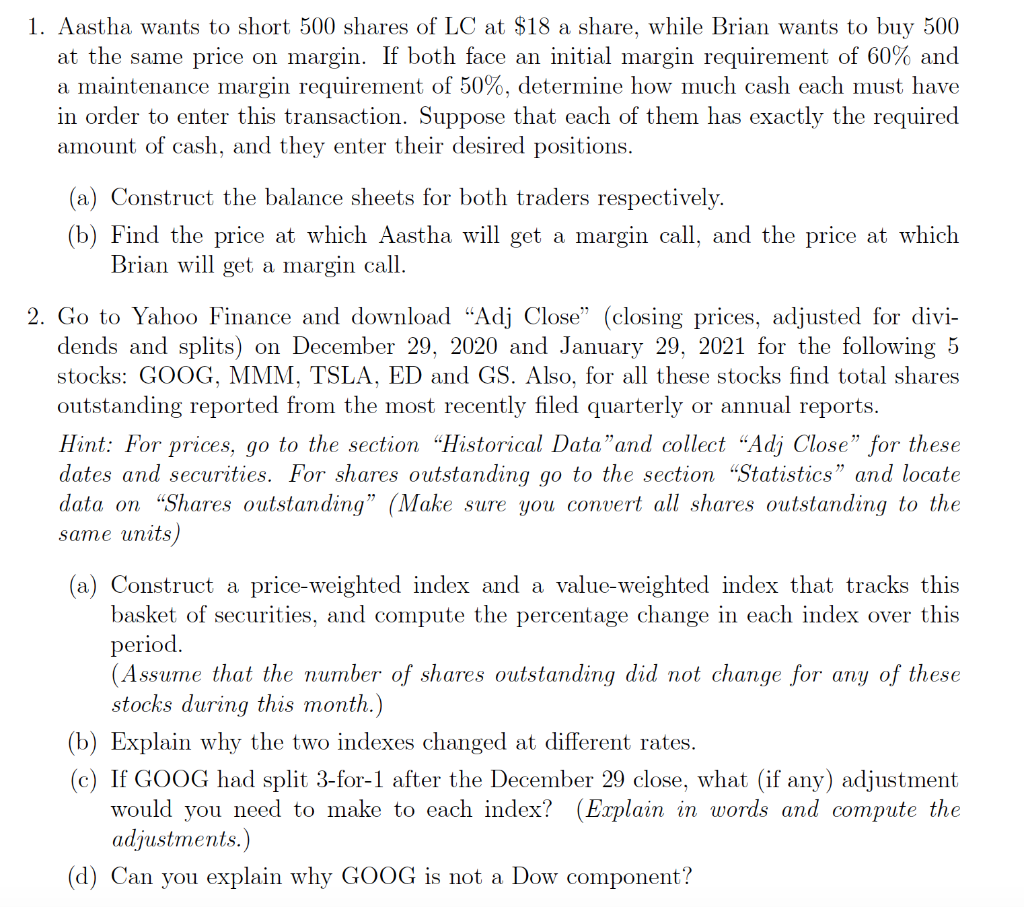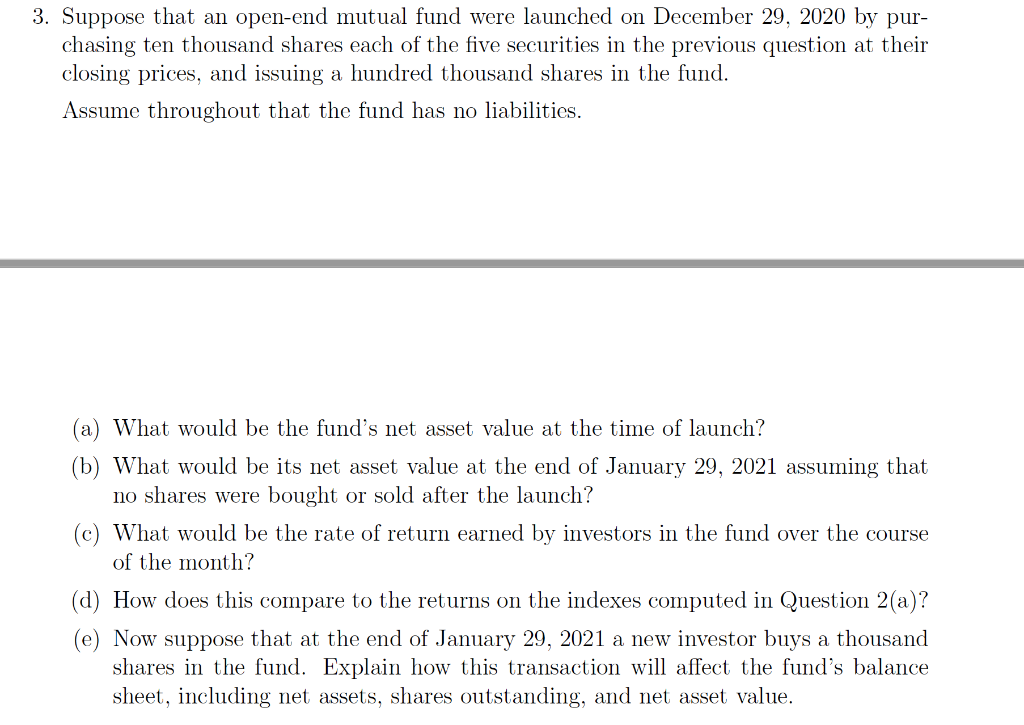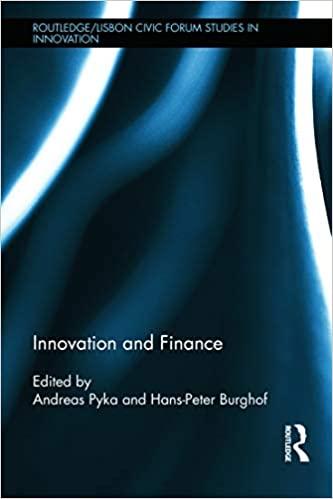

1. Aastha wants to short 500 shares of LC at $18 a share, while Brian wants to buy 500 at the same price on margin. If both face an initial margin requirement of 60% and a maintenance margin requirement of 50%, determine how much cash each must have in order to enter this transaction. Suppose that each of them has exactly the required amount of cash, and they enter their desired positions. (a) Construct the balance sheets for both traders respectively. (b) Find the price at which Aastha will get a margin call, and the price at which Brian will get a margin call. 2. Go to Yahoo Finance and download Adj Close (closing prices, adjusted for divi- dends and splits) on December 29, 2020 and January 29, 2021 for the following 5 stocks: GOOG, MMM, TSLA, ED and GS. Also, for all these stocks find total shares outstanding reported from the most recently filed quarterly or annual reports. Hint: For prices, go to the section "Historical Dataand collect Adj Close for these dates and securities. For shares outstanding go to the section Statistics and locate data on "Shares outstanding (Make sure you convert all shares outstanding to the same units) (a) Construct a price-weighted index and a value-weighted index that tracks this basket of securities, and compute the percentage change in each index over this period. (Assume that the number of shares outstanding did not change for any of these stocks during this month.) (b) Explain why the two indexes changed at different rates. (c) If GOOG had split 3-for-1 after the December 29 close, what (if any) adjustment would you need to make to each index? (Explain in words and compute the adjustments.) (d) Can you explain why GOOG is not a Dow component? 3. Suppose that an open-end mutual fund were launched on December 29, 2020 by pur- chasing ten thousand shares each of the five securities in the previous question at their closing prices, and issuing a hundred thousand shares in the fund. Assume throughout that the fund has no liabilities. (a) What would be the fund's net asset value at the time of launch? (b) What would be its net asset value at the end of January 29, 2021 assuming that no shares were bought or sold after the launch? (C) What would be the rate of return earned by investors in the fund over the course of the month? (d) How does this compare to the returns on the indexes computed in Question 2(a)? (e) Now suppose that at the end of January 29, 2021 a new investor buys a thousand shares in the fund. Explain how this transaction will affect the fund's balance sheet, including net assets, shares outstanding, and net asset value. 1. Aastha wants to short 500 shares of LC at $18 a share, while Brian wants to buy 500 at the same price on margin. If both face an initial margin requirement of 60% and a maintenance margin requirement of 50%, determine how much cash each must have in order to enter this transaction. Suppose that each of them has exactly the required amount of cash, and they enter their desired positions. (a) Construct the balance sheets for both traders respectively. (b) Find the price at which Aastha will get a margin call, and the price at which Brian will get a margin call. 2. Go to Yahoo Finance and download Adj Close (closing prices, adjusted for divi- dends and splits) on December 29, 2020 and January 29, 2021 for the following 5 stocks: GOOG, MMM, TSLA, ED and GS. Also, for all these stocks find total shares outstanding reported from the most recently filed quarterly or annual reports. Hint: For prices, go to the section "Historical Dataand collect Adj Close for these dates and securities. For shares outstanding go to the section Statistics and locate data on "Shares outstanding (Make sure you convert all shares outstanding to the same units) (a) Construct a price-weighted index and a value-weighted index that tracks this basket of securities, and compute the percentage change in each index over this period. (Assume that the number of shares outstanding did not change for any of these stocks during this month.) (b) Explain why the two indexes changed at different rates. (c) If GOOG had split 3-for-1 after the December 29 close, what (if any) adjustment would you need to make to each index? (Explain in words and compute the adjustments.) (d) Can you explain why GOOG is not a Dow component? 3. Suppose that an open-end mutual fund were launched on December 29, 2020 by pur- chasing ten thousand shares each of the five securities in the previous question at their closing prices, and issuing a hundred thousand shares in the fund. Assume throughout that the fund has no liabilities. (a) What would be the fund's net asset value at the time of launch? (b) What would be its net asset value at the end of January 29, 2021 assuming that no shares were bought or sold after the launch? (C) What would be the rate of return earned by investors in the fund over the course of the month? (d) How does this compare to the returns on the indexes computed in Question 2(a)? (e) Now suppose that at the end of January 29, 2021 a new investor buys a thousand shares in the fund. Explain how this transaction will affect the fund's balance sheet, including net assets, shares outstanding, and net asset value








